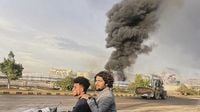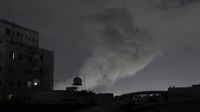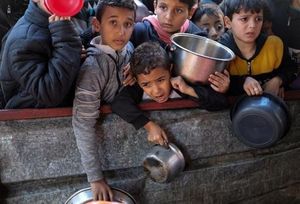On Sunday, August 24, 2025, the city of Sanaa in Yemen was rocked by a series of powerful Israeli airstrikes, intensifying an already volatile situation in the region. The strikes, which targeted key infrastructure and military sites controlled by the Iran-backed Houthi rebels, marked a significant escalation in the ongoing hostilities between Israel and the Houthis—a conflict that has increasingly drawn in broader regional and international interests.
According to multiple news agencies, including The Associated Press and TNND, the Israeli military confirmed that its fighter jets struck the Asar oil facility, the Hizaz power plant, and a military site near the presidential palace in Sanaa. The military described the power plants as “a significant electricity supply facility for military activities,” underscoring the strategic nature of the targets. Over 10 Israeli fighter jets were reportedly involved in the operation, which unfolded over several areas of the Yemeni capital.
The human cost of the strikes was immediately apparent. The Houthi-run health ministry reported at least six people killed and 86 wounded, with seven in critical condition. This figure was echoed by other sources, though some outlets, such as TNND, cited at least two deaths and 35 wounded—a discrepancy that highlights the chaos and confusion that often accompany such events. Residents described a harrowing scene. “The sounds of explosions were very strong,” Sanaa local Hussein Mohamed told The Associated Press. Another resident, Ahmed al-Mekhlafy, recounted, “The house was rocked, and the windows were shattered.”
Social media and Houthi-run Al-Masirah television broadcast images of a fireball erupting at the Asar oil plant, lending visual evidence to the widespread damage. Smoke was seen billowing near Sabeen Square, a central gathering place in Sanaa, and explosions rattled neighborhoods close to the presidential palace and a closed military academy. The strikes were the first in Yemen in a week, following an earlier Israeli campaign targeting energy infrastructure believed to be used by the Houthis.
The immediate catalyst for this escalation was a Houthi missile launch toward Israel just two days prior, on Friday, August 22. The rebels claimed they had fired a newly equipped missile—described by Israeli officials as a cluster munition—at Israel’s largest airport, Ben Gurion. Although the missile was intercepted and fragmented mid-air, causing no reported damage or injuries, Israeli military officials told The Associated Press that the use of cluster munitions represented a new technological threat, likely provided by Iran. The official noted that these munitions are “meant to detonate into multiple explosives on impact,” making them harder to intercept and signaling a worrying escalation in the capabilities of the Houthi arsenal.
For nearly two years, the Houthis have been launching missiles and drones toward Israel and targeting commercial and naval ships in the Red Sea. The rebels—who control much of northern Yemen—have said their operations are acts of solidarity with Palestinians amid the ongoing war in Gaza. According to The Associated Press, from November 2023 to December 2024, the Houthis targeted more than 100 ships with missiles and drones, severely disrupting shipping through a maritime corridor that sees nearly $1 trillion in goods pass annually. The attacks briefly ceased during a truce in Gaza but resumed soon after, further destabilizing the region and drawing in international actors.
In response to the airstrikes, Nasruddin Amer, the deputy head of the Houthi media office, took to social media to reaffirm the group’s commitment to its campaign. “Our military operations supporting Gaza won’t stop, God willing, unless the aggression is stopped, and the siege is lifted,” Amer wrote, as reported by The Associated Press and TNND. The Houthis have made it clear that their attacks on Israel and Israeli-aligned targets will continue, regardless of international pressure.
The Israeli government, for its part, defended the strikes as necessary measures. Defense Minister Israel Katz stated that Israel continues to “impose an air and naval blockade,” though he did not elaborate on the specifics. Prime Minister Benjamin Netanyahu was equally resolute, declaring in televised remarks that the Houthis are “paying a heavy price for its aggression.”
The broader context of these developments is one of persistent instability and shifting alliances. In May 2025, the United States brokered a deal with the Houthis aimed at ending airstrikes in exchange for a halt to attacks on shipping. However, the rebels maintained that the agreement did not cover their operations against what they considered Israeli-aligned targets, leaving the door open for continued hostilities. Earlier, Yemen had also been the target of a weeklong airstrike campaign ordered by then-President Donald Trump, a move that further complicated the conflict’s dynamics.
The impact on civilians has been devastating. In May 2025, Israeli airstrikes destroyed the Sanaa airport terminal and damaged at least six passenger planes, including three belonging to Yemenia Airways, according to airport authorities. The destruction of infrastructure—whether airports, oil facilities, or power plants—has compounded the suffering of ordinary Yemenis, many of whom are already grappling with the consequences of years of war, poverty, and humanitarian crisis.
The international community remains deeply divided over the conflict. Some observers argue that Israel’s actions are justified responses to ongoing attacks and the threat posed by Iranian-backed proxies. Others contend that the strikes risk worsening an already dire humanitarian situation and pushing the region closer to a wider conflagration. The Red Sea shipping disruptions have also alarmed global markets, given the sheer volume of goods transiting the area and the potential for further escalation to impact global supply chains.
Within Yemen, the strikes have only deepened the sense of uncertainty. Residents of Sanaa, already accustomed to the sound of distant shelling, now face the prospect of further violence and instability. For many, the hope for peace seems as distant as ever, with each new round of attacks and reprisals fueling a cycle of violence that shows little sign of abating.
As the dust settles over Sanaa, the world watches anxiously. The events of August 24 are a stark reminder of how quickly local conflicts can spiral into regional crises, pulling in actors near and far. For now, the people of Yemen—and the broader Middle East—are left to navigate the aftermath, uncertain of what the next day may bring.






